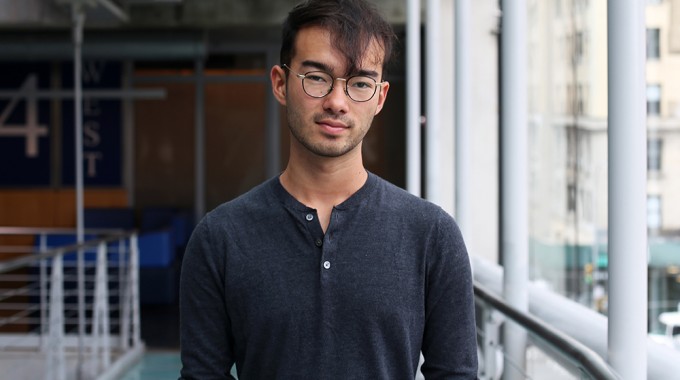If you know of a Columbia College student, faculty member, alumnus/alumna or program we should spotlight, or if you would like to submit a story, please contact:
Columbia College
Office of Communications
cc-comms@columbia.edu

“There’s a unifying aspect to the Columbia educational experience...whether navigating the lighthearted, informal, warm and welcoming, to conversations that are extremely complex and framed by what they’ve studied, everyone has baseline interest in the world around them.”—Aaron Smithson CC’19
On the oldest bridge over the Grand Canal that flows through the heart of Venice, Italy, Aaron Smithson CC’19 had one of the most memorable experiences of his undergraduate career. The New York City native was able to spend a summer in Italy studying art and architectural history, and building conservation, and, as he put it, “never once had a class in classroom.”
He found himself alongside conservators, leaving literal thumbprints on the Rialto Bridge, a landmark since the Renaissance.
“I will always remember until the day I die that I was the one who applied this concrete putty in the mortar gap between the twelfth and thirteenth stones on the far southern railing on the eastern side of the bridge.
“We never studied a piece of art or architecture without standing in front of or inside of it,” he said. “Being able to actively participate in the restoration of the architectural heritage of Venice was so incredible.”
The study abroad experience took place during the summer after his first year at Columbia College, and was funded by the Presidential Global Fellowship he received. When asked to reflect on whether there is a Core Competency that surprised him, he said, “Global experience. I wasn’t thinking actively about studying abroad; I’m now leaving college having studied abroad three times.”
An double major in urban studies, and history and theory of architecture, Smithson went on several trips, including one each to South America and Australia, each of which he credits as having enriched his overall College experience.
With the Global Scholars Program, he studied Latin American migration in five cities under José Moya, professor of history at Barnard and adjunct senior research scholar in the Institute for Latin American Studies. Smithson and 15 others traveled over five weeks to São Paulo; Rio de Janeiro; Montevideo, Uruguay; Havana; and Buenos Aires, Argentina, where they arrived just after a women’s rights protest in the famed Plaza de Mayo, the city’s central square and a historic center of Argentinian political life.
“To go to a place with the same people you’ve been studying the place with is truly unique, to see things appear before your eyes that you had read about extensively — seeing all these spaces and places come to life, and also the social dynamics and political discourse that you learned about — that was really special.”
Smithson knew that Melbourne, Australia was listed by The Economist as one of the most livable cities in the world for seven years, and so he chose to spend a semester there to learn more about community-led planning. He returned to campus with knowledge he then applied to surveying Columbia students and working with University administrators as part of a “Common Space Initiative” to suggest changes to some student lounges that Smithson notes “have been widely appreciated.”
“When I think of Columbia, I think of critically engaged people. People look for ways to improve their community, constantly,” says Smithson, who is a member of various campus service groups including the Columbia-Barnard Design for America chapter and Asian American Alliance.
He also credits the Core with helping students to build close relationships with broad groups of people, since students are able to discuss the Core with anyone, regardless of whether they share a professor or if they are classmates.
“There’s a unifying aspect to the Columbia educational experience,” Smithson points out. “Whether navigating the lighthearted, informal, warm and welcoming, to conversations that are extremely complex and framed by what they’ve studied, everyone has baseline interest in the world around them.”
Following graduation, Smithson plans to spend a year or two before graduate school growing his professional experience, with a New York City planning consultancy or urban studies nonprofit.
“I didn’t realize it before coming here, but being able to sit in seminar rooms with 20 people from different backgrounds has been the most eye-opening experience,” he said. “The extent to which Columbia affords you the opportunity to be exposed to other people — take that opportunity. You will not have it again.”